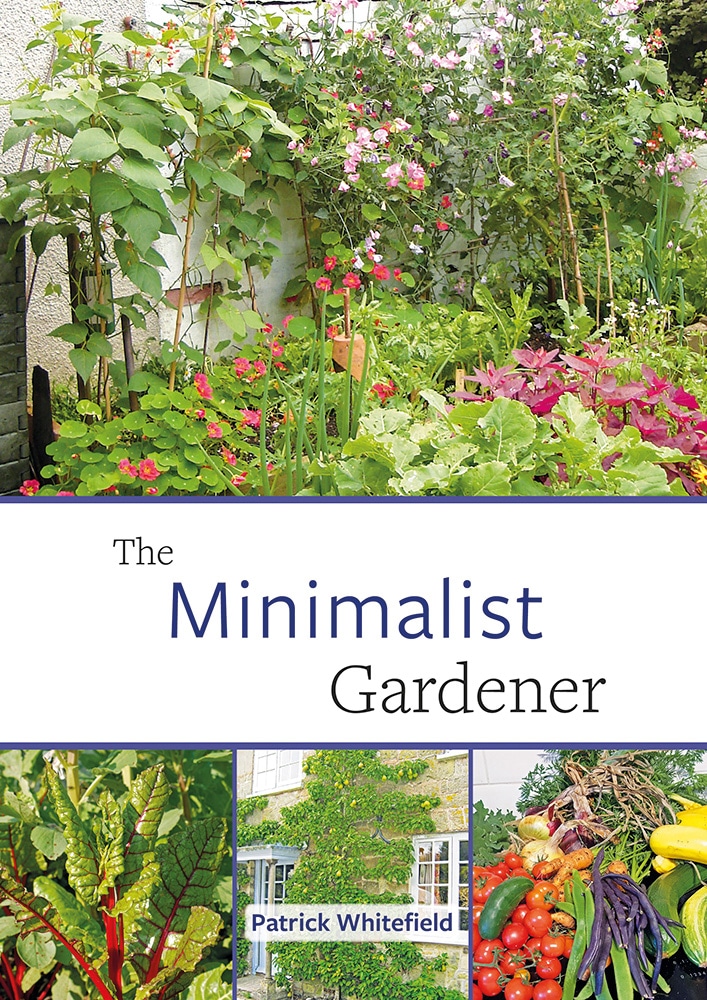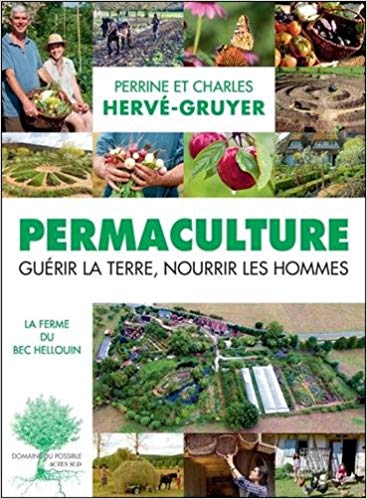D - ESP
<< >>
Bio-permaculture 01: cronology
Permaculture is agriculture that is preserving itself and almost ALWAYS works by itself - WITHOUT pesticides, almost WITHOUT machines, with maximum yield
"Permaculture is the creation of small paradises here on earth." (Bill Mollison) [web35]

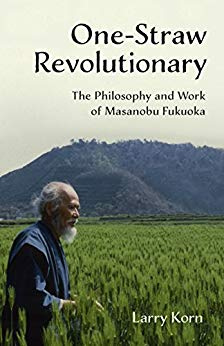
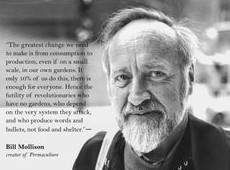
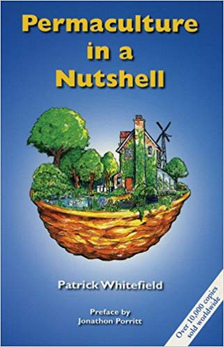

F.H. King: Farmers of Forty Centuries - Japan with Fukuoka, book: One-Straw Revolutionary - Bill Mollison from Australia - Patrick Whitefield from GB, book: Permaculture in a Nutshell - Toby Hemenway from the "USA", book: Gaia's Garden
by Michael Palomino (2018)
| Share: |
Facebook |
|
Twitter
|
|
|
|
"Industrial agriculture" is destroying soils, groundwater, biodiversity and soil with machines, monocultures and pesticides. That's why optimized organic farming with permaculture is needed [web01].
Web site of Permaculture Campus of Hamburg: http://permakultur-campus.de/
Web site of Permaculture Campus on Facebook: https://www.facebook.com/PermakulturCampus
Permakultur ist Landwirtschaft, die sich selbst erhält und fast von alleine IMMER funktioniert - OHNE Pestizide, fast OHNE Maschinen, mit maximalem Ertrag -- Der Pionier Franklin Hiram King -- Die Pioniere Bill Mollison (1928-2016) und David Holmgren (*1955) -- Permakultur-Felder -- Das Permakultur-Waldgarten-Konzept -- Die Permakultur-Fischteiche (Aquakultur) -- Bücher über Permakultur -- Die "Permanent agriculture" wird zur ethischen "permanent culture" ausgeweitet -- Australien 1978 Buch von Mollison "Permaculture One" ("Permaculture I") -- Australien 1981 Alternativer Nobelpreis für Bill Mollison -- ab 1981 Ausbildung in Permakultur - die korrupten Regierungen wollen nichts dazulernen und verweigern die Anerkennung! -- 1980er und 1990er Jahre: Bücher über Permakultur - die korrupt-satanistischen NWO-Regierungen interessiert es NICHT -- Zonierung des Bio-Landbaus gemäss Permakultur -- 1984: Masanobu Fukuoka (1913-2008): Der grosse Weg hat kein Tor -- 1984: Bill Mollison & David Holmgren: Permakultur. Landwirtschaft und Siedlungen in Harmonie mit der Natur -- 1992: Robert Hart: Der Waldgarten. -- 1994: Bill Mollison: Permakultur II. -- 1998: Fukuoka Masanobu: In Harmonie mit der Natur. -- 1998: Fukuoka Masanobu: Rückkehr zur Natur. -- 1999: Gerda & Eduard W. Kleber: Gärtnern im Biotop mit Mensch. -- 2002 Buch von David Holmgren: "Permaculture Principles" -- 2003 Buch von Patrick Whitefield (1949-2015): Permakultur kurz & bündig -- 2004: Patrick Whitefield: The earth care manual -- 2004: Graham Bell: Der Permakultur-Garten. Anbau in Harmonie mit der Natur -- 2004 Neue Idee: Umwandlung der Städte mittels Permakultur (Transition Towns) -- Bücher über Permakultur von 2004 - die korrupt-satanistischen NWO-Regierungen interessiert es nicht -- 2005: Buch über Waldgarten -- 2004: Sepp Holzer: Sepp Holzers Permakultur. -- 2006 Die UNO entwickelt die Permakultur-Akademie weiter -- 2006: Graham Bell: Permakultur praktisch. Schritte zum Aufbau einer sich selbst erhaltenden Welt -- 2007: Patrick Whitefield: Das grosse Handbuch Waldgarten. Biologischer Obst-, Gemüse- und Kräuteranbau auf mehreren Ebenen -- 2007: Sepp & Margit Brunner: Permakultur für alle -- 2008 Handbuch zur Umwandlung der Städte (Transition Towns) -- 2009: Toby Hemenway: Gaia’s Garden -- 2015: Toby Hemenway: Permaculture City -- 2010: Martin Crawford: Creating a Forest Garden -- 2012: Bill Mollison: Das Handbuch der Permakultur-Gestaltung -- 2013 Hamburg Permakultur-Campus: Ausbildung zum Diplom-Permakultur-Designer -- 2013: Mark Shepard: Restoration Agriculture -- 2017: Christoph Bachmann, Eva Bührer, Kurt Forster: Permakultur. Grundlagen und Praxisbeispiele
Cronology
"USA" 1911
The pioneer Franklin Hiram King describes sustainable cultivation methods in China, Korea and Japan as "permanent agriculture"
The "US" agricultural scientist Franklin Hiram King uses the term "permanent agriculture" for sustainable cultivation methods in China, Korea and Japan [web01].

Franklin Hiram King [1] - Franklin Hiram King's book on intensive organic farming in Asia for 40 centuries: Farmers of Forty Centuries: Organic Farming in China, Korea and Japan [2]
Rezension auf Amazon (Übersetzung) [web34]:since 1938
<For more than 40,000 years, Asian farmers worked the same fields repeatedly without sapping the land's fertility and without applying artificial fertilizer! How they accomplished this miraculous feat is described by author Franklin Hiram King, a former official of the U.S. Department of Agriculture. King traveled to Asia in the early 1900s to learn how farmers in China, Korea, and Japan were able to achieve successful harvests century after century without exhausting the soil — one of their most valuable natural resources. This book is the result of his extraordinary mission.
A fascinating study of waste-free methods of cultivation, this work reveals the secrets of ancient farming methods and, at the same time, chronicles the travels and observations of a remarkable man. A well-trained observer who studied the actual conditions of life among agricultural peoples, King provides intriguing glimpses of Japan, China, Manchuria, and Korea; customs of the common people; the utilization of waste; methods of irrigation, reforestation, and land reclamation; the cultivation of rice, silk, and tea; and related topics.
Enhanced with more than 240 illustrations (most of them photographs), this book represents an invaluable resource for organic gardeners, farmer, and conservationists. It remains "one of the richest sources of information about peasant agriculture [and] one of the pioneer books on organic farming." - The Last Whole Earth Katalog.> [web34]
Japan: Agricultural Inspector Fukuoka becomes an organic farmer changing farm
Masanobu Fukuoka, portrait [6]
Customs Inspector Mr. Fukuoka is chaning his life after pneumonia in 1937, returning home to southern Japan, takes over a farm and converts it to organic agriculture. With experimentation he achieves a self-regulating agriculture, with rice-barley crop rotation, with a citrus garden, especially citrus trees and vegetables, and with the seed balls (clay balls with a seed mixture inside). So he lets nature decide where grows what, because simply the seed balls are scattered around. He lets nature produce his own compost with the many trees in the citrus garden, he does not scatter any compost himself. Its system works at minimal cost and effort, and harvests are excellent. However, pioneer Fukuoka has many enemies in Japan, because some farmers only implement parts of the concept and thus achieve no success.
Fukuoka with his Do-Nothing-landscape (Daoist principle of Wu-wei): Fukuoka invented the "seed bombs" (direct seeding method with rice without pow) -- Principle: Nature is able to sustain itself - it becomes a variety of plants combined for an ecological balance - protect crops from pests - the soil continues to enrich with nutrients - fields and gardens are with many animals and plants, no plowing or chemical fertilization necessary - nature is fertilizing [with many trees in the citrus garden, and by straw mulch] and also the protection against pests can be taken over by nature [by the right combination of plants, flowers, shrubs and trees] - sowing and harvesting is the only thing that humans need to do - The agricultural area for humanity can decrease with this method, because per m2 much more grows - the food is adapted to the seasons, and must be low in meat in - Fukuoka maintains a double crop rotation without plow: Rice and winter barley is planted alternately - White Clover acts to control weeds, AND also to provide nutrients to the soil - 1988 Ramon Magsaysay Prize - book "The One Straw Revolution" [web49].
5 principles of Fukuoka
1. Plowing or tilling is not required, no engine machines
2. No fertilizers, no compost
3. No weeding, no pesticides, only minimal weed control
4. No pesticides, no herbicides
5. No pruning of fruit trees [web50].
Web site about Fukuoka
Australia 1970s
The pioneers Bill Mollison (1928-2016) and David Holmgren (* 1955)
Two Australians Bill Mollison and David Holmgren are developing permaculture from organic farming in Europe and inventing the term of "permaculture" combining the two words permanent agriculture - agriculture that ALWAYS works (sustainable farming) [web01].

Bill Mollison, portrait (1928-2016) [3] - David Holmgren in a garden [4]
Translation: <Bruce Charles "Bill" Mollison (born May 4, 1928 in Tasmania, Australia, † September 24, 2016 in Sisters Beach, Tasmania) was, along with David Holmgren, the "father of permaculture". In 1978 he founded the Permaculture Institute, dedicated to the spread of permaculture in education, research and effectifve implementation. In 1981 he was awarded the Right Livelihood Award.> [web36] The Permaculture Institute is on a 147-acre Tagari Farm in northwestern Australia [web39]
In 1979 Mollison founded a permaculture newspaper "Tagari" based in Tasmania, in support of the Permaculture Institute with publications and book sales. The profit is transferred annually to the Permaculture Institute [web44]. Address (link): Col. Sisters Creek - Waratah-Wynyard Council - Tasmania - Australia - Website: www.tagari.com [web42]. The word "Tagari" comes from the language of the Tasmanian natives and means "those who are gathered here" or simply "we, the people" [web44].
Wikipedia says about Mollison:
<Bruce Charles "Bill" Mollison (4 May 1928 – 24 September 2016) was an Australian researcher, author, scientist, teacher and biologist.
He is referred to as the "father of permaculture."[2][n 1] Permaculture (a portmanteau of "permanent agriculture")[3] is an integrated system of ecological and environmental design which Mollison co-developed with David Holmgren, and which they together envisioned as a perennial and sustainable form of agriculture. In 1974, Mollison began his collaboration with Holmgren, and in 1978 they published their book Permaculture One, which introduced this design system to the general public.
Mollison founded The Permaculture Institute in Tasmania, and created the education system to train others under the umbrella of permaculture.[4][n 2] This education system of "train the trainer", utilized through a formal Permaculture Design Course and Certification (PDC), has taught thousands of people throughout the world how to grow food and be sustainable using permaculture design principles. In 1981 he was awarded with the Right Livelihood Award (also known as "Alternative Nobelprize") for his accomplishments in the field of permaculture.> [web37]
Since 1997, Geoff Lawton and Nadia Lawton have been leading the Permaculture Research Institute, which is now relocated to another farm, the "Zaytuna Farm", with 27 hectares [web43]. Website: https://zaytunafarm.com/ - Contact information for courses: https://zaytunafarm.com/contact-us/ - or here link with the address: Permaculture Research Institute - 1158 Pinchin Rd. - The Channon NSW 2480 - Australia (south of Brisbane) - Phone: 0061 (0) 2 6688 6578 - E-mail for general inquiries: office@permaculturenews.org, Inquiries for courses: education@permaculturenews.org [web40].
Wikipedia says about Holmgren (translation):
<David Holmgren (* 1955 in Australia) is next to Bill Mollison, the co-founder of the 1978 first published permaculture concept (book: Permaculture One, composed of permanent and agriculture = permanent and sustainable agriculture). While Mollison has come out in public with his numerous appearances and focus on permaculture teaching and dissemination and received the Right Livelihood Award ("Alternative Nobel Prize") in 1981, David Holmgren is conscientious both theoretically and in practice and detailed researcher and user of permaculture principles. With his new book "Permaculture. Principles and Pathways Beyond Sustainability" he is currently the most advanced thinker of the global permaculture movement. His own (since 1985) existing project "Melliodora" [of 1 hectare with two ponds, flower beds and since 2005 with a passive house] is not only one of the most famous demonstration projects in Australia, but it also identifies him as an outstanding permaculture practitioner and designer with a broad and sound knowledge.> [web38]
Holmgren's web site says additionally: <David lives with his partner Su Dennett at “Melliodora”, a one-hectare permaculture demonstration site at Hepburn Springs, Central Victoria, Australia. Visit his web site at holmgren.com.au [which is relevant for house gardening and gardening in appartment buildings].> [web41]
The permaculture pioneers Mollison and Holmgren follow the following guidelines for their permaculture:
-- Working with nature and not against nature with well sophisticated observations WITHOUT thoughtless actions in the name of money and stock market
-- Installing of productive agriculture ecosystems concerning of all their functions being capable to develop themselves demonstrating "their own evolution"
-- These agriculturally productive ecosystems consist of perennial and annual plants and species that reproduce themselves [web01]
-- There must be plants and animal species of the respective region, "in accordance with the respective environmental conditions", full diversity [web01]
-- the natural ecosystems have full stability and resilience
-- it is necessary to satisfy the needs for impeccable food [web01].
Guiding principles: long-term instead of short-term - diversity instead of simplicity - sustainable optimization instead of short-term maximization - optimization instead of maximization - cooperation instead of competition [web01].
The ecosystem of permaculture regulates itself to a large extent and requires only minimal intervention, so a dynamic equilibrium is maintained - for the next generation should be left an intact world, with continuous production and adaptability, also with self-regulation processes [web01].
Permaculture fields: green manure with mulch and direct seeding without machinery [web01].
Later are also developed:
The permaculture forest garden concept: with a mixed forest (trees, shrubs, bushes, herbs, groundcover, vine plants) combined with fields for agriculture. The forest part regenerates itself, with optimal work with light, with numerous niches for all sorts of animal species, with a high productivity per m2. The suggestion came from India and was adapted for the temperate climate in Central Europe.
The permaculture fishponds (aquaculture): with several fish species at the same time, different floors and plantings, niches for food fish, where predatory fish cannot get in, planting of the pond edge [web01].
1973
England: New economy of natural efficiency by Ernst Friedrich Schumacher: "Small is beautiful"



E. F. Schumacher [50], book "Small is beautiful" 1973 01 [48] - 02: black with landscape [49]
In 1973 The British economist Mr. Ernst Friedrich Schumacher published the book "Small Is Beautiful: Economics As If People Mattered" with a collection of essays on the principle of natural efficiency in life [web55].
Its principles are also applicable to efficient agriculture with organic farming and permaculture. That's why Schumacher became a leading figure in organic agriculture and permaculture since 1973 [this is even mentioned in the Mossad CIA Wikipedia - web56]. The German translation of "Small is beautiful" came out in 1977 [web57] - Amazon Link
Cover text on Amazon:The hurdle of organic farming and permaculture is simply that people need to learn how the ecosystem works. One has to know every plant and fly! THAT is the big hurdle. The pioneers who have done that are publishing their books: Mollison, Fukuoka, Robert Hart, Geoff & Lawton, Glue, Holmgren, Whitefield, Hopkins, Graham Bell, Sepp Holzer, Herve-Gruyer, Jacket & Toensmeier, Sepp & Margit Brunner, Hemenway, Crawford, Shepard , Bachmann / Bührer / Forster. But the alcoholic NWO governments with their corrupt pharmaceutical ministers are not interested!
"Small Is Beautiful is Oxford-trained economist E. F. Schumacher’s classic call for the end of excessive consumption. Schumacher inspired such movements as “Buy Locally” and “Fair Trade,” while voicing strong opposition to “casino capitalism” and wasteful corporate behemoths. Named one of the Times Literary Supplement’s 100 Most Influential Books Since World War II, Small Is Beautiful presents eminently logical arguments for building our economies around the needs of communities, not corporations."
Reader's comment on Amazon (translation):
"What's happening today is described in the 70's! Unbelievable how current this book is in relation to the current financial crises."
Here come books!
Australia 1978
Book of Mollison "Permaculture One" ("Permaculture I")
Bill Mollison publishes his first book on permaculture: "Permaculture One" [web01].
This book marks the beginning of a worldwide movement to transform criminal machine-pesticide agriculture into permaculture farming. However, the pharma-corrupt NWO governments are hardly taking permaculture seriously until today (2018).
1979
Book of Bill Mollison: Permaculture II.
Practical applications
Customer's comment:
Translation: <Very informative book, I can only recommend it! Many practical examples, and new ideas.> [web20]
1980s
The "permanent agriculture" is extended to the ethical "permanent culture"
With Mollison and Holmgren, hundreds of projects are being realized, and permaculture is being tested and refined testing the patterns. Likewise, social aspects are included, so that permaculture evolves from a "permanent agriculture" to be a "permanent culture" with the slogan "Earthcare and Peoplecare" for a caring life on Earth:
-- careful handling of planet Earth
-- careful treatment of people for getting enough food, and
-- Modesty in life to preserve planet Earth, as well
-- Distribution of overproduction or return of surpluses to natural cycles [web01].
The principles of permaculture have since been applied to other areas of life:
-- in architecture
-- in urban development
-- in regional planning
-- in the cooperative economy
-- in software development [web01].
Australia 1981
Alternative Nobel Prize for Bill Mollison
Bill Mollison receives the Alternative Nobel Prize [web01], the "Right Livelihood Award" [web02], for "researching and describing the principles of this form of natural agriculture" [web01].


Pioneer Bill Morrison [3] - Right Livelihood Award, Logo [41] - Jakob von Üxküll, Ökologie-Schriftsteller [52]
The Swedish ecology writer and politician Jakob von Uexküll [web60] said that there must also be a Nobel Prize for Ecology and another one for strategies against poverty. The Nobel Committee refused. As a result, Üxküll founded the Right Livelihood Award in 1980 [web19].
Translation:
<The Right Livelihood Award (RLA) meaning something like "Award for the right manner of living" is an award "for the creation of a better world". It has been awarded annually by the Right Livelihood Award Foundation since 1980 and is funded with donations.
The term Alternative Nobel Prize was created in public during the first years of the award, but is not the official name of the prize and is used by the awarding body only in quotation marks. There is no institutional link between the price and the Nobel Prize; in English-speaking countries, the term is used less frequently for the award than in German.> [web19]
1981
Bill Mollison: The response speech "The Birth of a Global Movement"
In 1981, the co-founder of permaculture won the Right Livelihood Award. The quote comes from his response with a description of his motivation for starting out of nowhere and his determination to find solutions starting with the ecological collapse. [web02]
"The greatest change we need to make is from consumption to production, even if on a small scale, in our own gardens. If only 10% of us do this, there is enough for everyone. Hence the futility of revolutionaries who have no gardens, who depend on the very system they attack, and who produce words and bullets, not food and shelter." ab 1981 - Bill Mollison, creator of Permaculture) [web02]
Training in permaculture - the drug-corrupt NWO governments do not want to learn anything and refuse recognition!
The permaculture movement installs permaculture networks and its own education system:
-- there is schooling getting at the end a "Permaculture Design Certificate" (PDC) with the basics of permaculture in 72 lessons, based on the book by Mollison and Holmgren "Permaculture Designer's Manual" - even without previous knowledge
-- there is also a "Diploma of Applied Permaculture"
-- Permaculture Campuses are installed
-- There is schooling for Certified Permaculture Designer withint 2 to 3 years, i.a. at the Permaculture Academy with the "Diploma of Applied Permaculture" [web01].
Permaculture design course certificate [42]
The corrupt satanic NWO governments, all controlled by Rothschild and the 300 committee, refuse to acknowledge permaculture education [web01].
1983
Australia: Geoff Lawton makes his Permaculture Certificate (PDC)
In 1983 Geoff Lawton from Australia is graduated by educaiton with Bill Mollison getting a Permaculture Certificate (PDC) and since 1985 he has been an ambassador of permaculture around the world in more than 50 countries with courses and advice to restore ecosystems. He has been director of the Permaculture Research Institute in Australia since 1997, founded by Bill Mollison. The institute is relocated then by Lawtons in 1997 from Tagari Farm to Zaytuna Farm [web45]. Later, he will take over the permaculture research institute in Australia.

Geoff Lawton with chicken, portrait [43]
1980s and 1990s: books on permaculture - the drug-corrupt, satanic NWO governments are NOT interested
1984
Book of Masanobu Fukuoka: One Straw Revolution
Book of Masanobu Fukuoka (1913-2008) -
(German: Der grosse Weg hat kein Tor. Nahrung - Anbau - Leben. Edition Pala, Schaafheim 1984, ISBN 3-923176-14-7 [web01]
Masanobu Fukuoka, portrait [6] - Masanobu Fukuoka's book: "One Straw Revolution" (1984) [7] - Amazon Link
This book is Masanobu Fukuokas most important work about his natural cultivation and the idea behind the nothing-doing-agriculture. The title "The One Straw Revolution" also means something like: How a straw [straw for mulching] can trigger a revolution - and what Masanobu Fukuoka has to say about mulching, natural cultivation and nutrition [web03].
Reader's descriptions from Amazon:
Translation: <The book "One Straw Revolution" is a principle book of alternative life and of the alternative nutritional movement. It inspires people around the world to look for new ways of life. A success story of organic farming - and much more: For Masanobu Fukuoka, the sensible handling of the soil was a step towards the reconciliation of humans with themselves and their environment.
The book "One Straw Revolution" has been translated into more than 25 languages. In 1983, the German version appeared for the first time in the Pala publishing house. The book provides insights into Fukuoka's worldview as well as the methods of his natural agriculture. Further topics are: our dealings with food, nutrition and the limits of human wisdom.
When we change the way in which we grow our food, we change our food, we change our values. And so, this book is about paying attention to conections, causes and effects, and assuming responsibility according to one's own knowledge: a book on agriculture that is so important because it's not just about agriculture.> [Web32]
Customer review: Man knows practically nothing:
Translation: <An insanely good book on permaculture and generally about the fact that humans do not really know anything. Recommended for everyone, especially for people who would like to live in an independent way.> [Web32]
Customer review: An eye opener:
Translation: <An absolute must for anyone who wants to explore the topics of nutrition, sustainability, the environment, the future, food production, permaculture and agriculture. Never boring or uninteresting, but an eye-opener on many levels.> [Web32]
Customer review: Pesticides are not needed:
Translation: <That is one of the best books on natural cultivation and permaculture.
It was fun to read the book and you really learn. Masanobu Fukuoka is not only a gifted peasant but also a philosopher.
In my opinion everything is important what you first know and about permaculture and how is nature and how is the plant world working and what makes humanity wrong today and what you can do wrong. I hope we return eventually to reason and will stop spraying on the fields with poisonous chemistry spray because we believe that it must be so, no you can also have high yields without this when you know how! Nature will thank humans for this!> [Web32]
Customer review: Simple and deeply written:
Translation: <Hard to beat for profundity, wisdom and authenticity. And yet so simple, not simple, simple. This book tempted me to read all 4 books by Fukuoka. Only recommended.> [Web32]
1985
Book of Fukuoka: The Natural Way Of Farming
The Theory and Practice of Green Philosophy. Japan Publications 1985, ISBN 978-0-87040-613-3.
[web49]
1987
Book of Fukuoka: The Road Back to Nature
Regaining the Paradise Lost. Japan Publications 1987, ISBN 978-0-87040-673-7.
[web49]
1987
Book of Patrick Whitefield: Tipi Living
[web09]
1992
Book of Robert Hart: Forest Garden
Editor: PiKS, Steyerberg 1992, ISBN 3-929321-00-9
Robert Hart in his Forest Garden [9] - brochure (50 pages) by Robert Hart: The Forest Garden - which is more about forest than garden (1992) [10] - Amazon link
A customer review says, this book by the Englishman Robert Hart brings little to the topic of forest garden, but more on the subject of forest:
Translation: <So you should not expect in-depth information on the subject of Forest Garden from this booklet, the booklet pours out in general sentences: "what is a forest, only a few people in England have ever seen a real forest." well, for me a whole new insight! but to the actual topic of forest garden work and the idea of Robert Hart one learns little useful. On the other hand, books such as "the great handbook Forest Garden" by Patrick Whitefield or "Handbook School Garden" (original German: "Handbuch Schulgarten") by Gerda Kleber with the fruit tree life community are sources of useful and practical information, things that one can implement, including philosophical approaches.> [web04]
But there will come a second book of Robert Hart, a big one!
1993
Book of Patrick Whitefield (1949-2015): Permaculture in a nutshell
1994:
The farmer's son Patrick Whitefield (1949-2015) from Somerset (England) studied agriculture and then experienced agriculture in the Middle East and Africa for years, then returned to Somerset, bought a flower-rich hay meadow "White Field" at Butleigh for preserving this meadow as a nature reserve. He was a vegetable farmer and practiced several crafts. He was a member of the Ecology Party (forerunners of the Greens in England and Wales) and became strong in permaculture from 1990 - now officially a permaculturist. He taught permaculture courses in England, was a permaculture consultant and published several books. He was the first with an online permaculture course in England (http://patrickwhitefield.co.uk/). His work is living on in the Patrick Whitefield Society (Patrick Whitefield Associates). Books:
1987: Tipi Living - 1993: Permaculture in a Nutshell - 1996: How to Make a Forest Garden - 2004: Earth Care Manual - 2010: The Living Landscape, How to Read and Understand - posthumously 2017: The Minimalist Gardener [web09 ]
Web site for permaculture courses online: http://patrickwhitefield.co.uk/ - also: http://patrickwhitefield.co.uk/permaculture-courses/
Web site about his books: http://patrickwhitefield.co.uk/books/
Eine Leserrezension zum Buch "Permakultur kurz & bündig" (2003) (Übersetzung des Buchs Permaculture in a Nutshell):
<Das vorliegende Buch schliesst eine Lücke im Angebot der bereits vorhandenen Literatur über Permakultur, denn es zeigt dem interessierten Neuling an vielen praktischen Beispielen, wie Permakultur tatsächlich im täglichen Leben umgesetzt werden kann. So beschäftigt es sich mit Permakultur in der Stadt und auf dem Land (Garten, Bauernhof) sowie in der Gemeinschaft und beantwortet häufig gestellte Fragen zur Permakultur ganz allgemein. Eine weitere Besonderheit des Buches ist, dass die hier gemachten Tipps sämtlich auch in der gemässigten Klimazone umgesetzt werden können.> [web05]
Book of Graham Bell: The Permaculture Garden (first edition)
[web61]
Graham Bell lives in northern England near the Scottish border. His wife Nancy and he have created a forest garden, from which they feed themselves and have also their firewood. The wildlife is fantastic. The two children Ruby and Sandy develop the place in terms of energy efficiency. [Web47]

Graham Bell, portrait[20] - Graham Bell at a lecture [21] - book by Graham Bell: Permaculture Garden (second edition) [] - Amazon-Link
Courses with Graham Bell: http://grahambell.org/
Graham Bell is presenting his articles on his website: http://grahambell.org/posts
Examples of permaculture facts by Graham Bell:
-- Aphids and the yellowing disease, can be eliminated with enemies: blue tits, ladybirds, lacewings [web48]
-- Field margins attract invertebrates and songbirds [web48]
-- Agriculture and forestry are one unit, one can not operate them separately [web48]
-- Monocultures eliminate wildlife [web48]
-- Scavengers (nudibranchs, snails, rats) eliminate animal carcasses [web48]
-- Invasive exotic plants should not be allowed because they have no natural enemies in Europe: giant hogweed, Japanese herb sponge, Himalayan balm, New Zealand flatworm, mink [web48]
-- Birds of prey (raptors) and badgers do not harm [web48]
-- Wasps pollinate, decay deadwood, eat snails [web48]
-- Thistles and stinging nettles are pioneer plants for the regeneration of damaged soils, are food plants for butterflies and moths, are medicinal plants [web48]
-- Earthworms are ground handlers [web48]
-- Weeds create new ground [web48]
1996
Book of Fukuoka: The Ultimatum of God Nature
The One-Straw Revolution. A Recapitulation. Shou Shin Sha 1996.
[web49]
1996
Book of Patrick Whitefield: How to Make a Forest Garden
[web09]
This book describes forest gardening principles with fruits, vegetables and herbs on several levels. There are reader's comments from the German version (Das grosse Handbuch Waldgarten) [web30]:
Book description (description):1996
<Sustainable forest gardens have existed in the tropics for centuries. These are ecologically richly networked and economically viable systems for the indigenous population in the so-called subsistence economy, which, once established and ready for production, in principle demand only harvest work. They are the model for the European forest garden.
The long-standing, well-known beyond the UK, bio garden practicer, permaculture designer and teacher Mr. Patrick Whitefield shows in his practice-oriented book step by step, how very similar gardens under Central European climate and soil conditions under consideration of a specific species and variety choice can be designed and sustainably maintained. This refers to large and smaller gardens, which are created as an "edible" miniature forest landscape.
Such "edible" forest gardens are complex gardens with several floors of, for example, multi-year vegetable, medicinal and aromatic plants, wild berries as ground cover, berry bushes as middle floors and nut trees as so-called superstores. In short: a multifunctional, sustainable habitat for plants, animals and humans.> [Web30 - Amazon Link (German version) - Amazon Link (English version)]
Book of Robert Hart: The book "Forest Gardening"
(259 pages)
Robert Hart is mixing here history, philosophy, anthropology, and seasonal garden wisdom in a clear sequence of essays that together form a remarkable testimony to the joys of "hands-off" and practical gardening. This book "Forest Gardening" is truly a book for our time that offers a fresh sensibility that will encourage and inspire organic gardeners around the world [web51].

Book of Robert Hart: Forest Gardening Version 1 [44] - Version 2 [45]
The book tells the story of how Robert Hart in Shropshire transformed a small farmer's garden into a fruit forest garden, a habitat for songbirds, butterflies and other vertebrates - classic backyard permaculture. Robert Hart experimented with horticulture for decades, and now his results come in the book:
-- he established design guidelines
-- he made lists of recommended plants and varieties according to climatic zones
and explains how plants from the ground-cover plant to the large tree live and interact productively together [web51].
Kundenrezensionen:
1997
Geoff and Nadia Lawton leading the Permaculture Research Institute - "Zaytuna Farm"
Geoff Lawton and Nadia Lawton are leading the Permaculture Research Institute which is relocated then to another farm, the "Zaytuna Farm", 27 hectares big [web43]. Link with the address: Permaculture Research Institute - 1158 Pinchin Rd. The Channon NSW 2480 - Australia (south of Brisbane) - Phone: 0061 (0) 2 6688 6578 - E-mail for general inquiries: office@permaculturenews.org, inquiries for Courses: education@permaculturenews.org [web40].
Description of the Zaytuna Farm Link
1997
Book of Bill Mollison: Permaculture. A Designers' Manual
(German version: 2012: Handbuch der Permakulturgestaltung)
2002
Book by David Holmgren: "Permaculture Principles"
"Permaculture. Principles and Pathways Beyond Sustainability" [web01]
Holmgren describes the transition from criminal, energy-wasting machine farming to a "sustainable and life-friendly low-energy culture" [web01].
Holmgren defines 12 design principles in this book:
Table: The 12 Design Principles of Permaculture by Holmgren - Book "Permaculture Principles" of 2002
1.
Observe and Interact – Careful observation of systemic processes and thoughtful interaction with the system elements. 2. Catch and Store Energy – Rediscovery and adequate use of energy sources that have been important (for survival) natural wealth for all cultures: water, soil humus, seeds and trees. Particular attention to local and regional autonomy in order not to be 'externally dependent' in the age of energy transition.
3. Obtain a Yield – Implementing and sustaining profitable systems will inspire imitators. Successful permaculture systems will spread (private and municipal self-sufficiency).
4. Apply Self-regulation and Accept Feedback – Recognize and use self-regulation processes (productive feedback loops) in the systems. The fewer systems that have to be intervened, the less likely they are to interfere with causing labor-intensive consequential damage.
5. Use and Value Renewable Resources – Careful but productive use of renewable resources (sun, wind, water, biomass). At the same time, one can reduce the input of non-renewable resources.
6. Produce No Waste – Waste avoidance and recovery cascade with recicling: refuse, reduce, reuse, repair, recycle
7. Design from Patterns to Details – Successful design first requires an understanding of the supreme patterns in nature. The planned and desired details of a permaculture project take into account these patterns and follow them (top-down thinking, bottom-up action).
8. Integrate Rather than Segregate – Cooperation of diverse elements instead of elimination of singular elements and competition among each other.
9. Use Small and Slow Solutions – Small and slow solution strategies make systems more manageable for people and more productive over the long term than large ones with high energy requirement and high time requirement.
10. Use and Value Diversity – Use and preserve the diversity of elements in systems. This increases the reliability and in turn allows long-term self-organization.
11. Use Edges and Value the Marginal – Recognize and use the wealth and importance of peripheral zones (where are transitions of systems).
12. Creatively Use and Respond to Change – Creative use of natural cycles and succession sequences in order to respond flexibly and adequately to future challenges.
Zoning of organic farming according to permaculture
Zone 0: Housing - Zone 1: Spices - Zone 2: Vegetable Garden - Zone 3: Vegetable fields and cereal fields - Zone 4: Meadows, fruit trees, nut trees - Zone 5: Forest (rest area) [web01].
Edge zones may be enlarged (e.g., forest edge imitations) or reduced in size (e.g., protrusions and extensions on buildings).
2004
New Idea: Transforming Cities by Permaculture (Transition Towns)
In 2004, Louise Rooney and Rob Hopkins (from Ireland [web06]) present a new permaculture idea for adapting cities to permaculture [web01]. His first city to transform and reduce oil dependency was Kinsale in Ireland. His book Transition Handbook is published in 2008 [web05].
Books about permaculture of 2004 - the Satanist corrupt NWO governments are not interested
Rob Hopkins: The Transition Handbook (2008) [17] - Amazon-Link
Customer Review from Germany (translation):
<Not only are the new terms difficult, it hurts a bit to hold this book in your hands and to feel the discrepancy between our German still-reality and the "actually necessary". The demand that Rob Hopkins places on the individual certainly also causes difficulties.> [Web24]
2004
Book of Patrick Whitefield: The earth care manual.
A permaculture handbook for Britain and other temperate climates. Permanent Publications, East Meon Hampshire 2004, ISBN 1-85623-021-X

Patrick Whitefield, Portrait [18] - book: Earth Care Manual Permaculture Handbook (2004) [19] - Amazon-Link
2004
Book of Sepp Holzer (Austria): Permaculture of Sepp Holzer
(original German: Sepp Holzers Permakultur) - Leopold Stocker Edition, Graz 2004, ISBN 3-7020-1037-8.
Sepp Holzer maintains a pond permaculture. The farmboy Sepp Holzer from Krameter Farm in Lungau in Austria developed his own Holzer Permaculture with the combination of old and new methods: terraced slopes, raised beds on the floor, raised beds in wooden frames, animal husbandry, care of alpine and cultivated plants. The storage and use of water plays a central role, above all in drylands, where mostly only rainwater is used, with natural design of ponds. Holzer had years of quarrels with stubborn NWO authorities, because Holzer's permaculture did not meet the "recommendations and requirements" of the Ministry of Agriculture. The book "The Agrarian Rebel" (German: "Der Agrarrebell") presents the fights with crazy justice. Holzer regularly gives seminars and is active worldwide as an agricultural and pond consultant [web07]. Holzer integrated the dam culture with horticulture on the wedge-shaped dams. He clearly means that every country can be a "harvest country" [web08].
Book by Sepp Holzer: Permaculture (2004) [23] - Sepp Holzer also integrated the dam planting culture, the cultivation of the wedge-shaped dams [24] [so the acreage is doubled] - Amazon link
2004
France: Foundation of the farm in Le Bec Hellouin by the Hervé-Gruyer family - from 2008 with Permaculture
Website of the permaculture farm: https://www.fermedubec.com/
Book by Charles Hervé-Gruyer about his experiences with indigenous people (French): La femme feuille
Book by Perrine Hervé-Gruyer about the new life with permaculture (French): La relaxation en famille
Book about experiences and learning processes with permaculture (French) [web54]: Permaculture - Guérir la Terre, nourrir les Hommes - Amazon-Link (Permaculture - healing the earth, feeding people)
Farm in "Le Bec Hellouin" in France, Charles Hervé-Gruyer explains the hill bed (on the ground) principle, scheme [46] - The hill beds of the permaculture farm "Le Bec Hellouin" forming a large mandala, aerial view [47]
In 2004 Charles Hervé-Gruyer and Perrine Hervé-Gruyer took over a farm in the French village Bec Hellouin to feed their children with good vegetables and fruits. In 2006 they made the farmers diploma. Before Charles had a sailing school and was 20 years with his school sailing ship and knew aboriginal people (Amazonas, Africa, Papuans, Aborigenes in Australia etc.), getting to know their life in harmony with nature made book publications and movies about them, among others the book "The woman with the leaf" ("La femme feuille"). The permaculture farm is inspired by his family in harmony with nature. His wife Perrine left top sports and business from capitalist life and turned to nature. She advises more permaculture farms. During further education events they detected permaculture and its elements being tought by Eliot Coleman and in 2008, they converted a little part of her farm into a permaculture system [web53].
The conversion took place with a mandala garden, with garden islands, and with an orchard forest (garden forest) - forest gardening and hill bed farming. The yields increased, and agronomists and vegetable gardeners began to admire the farm in Le Bec Hellouin. The development was scientifically accompanied. The National Institut of Agriculture Investigation (Institut national de la recherche agronomique) and the Technical Agricultural Institute AgroParisTech confirmed the large yields on a small space. The farm became an extended family with many employees. The experiences are described in the book of 2018 Permaculture - heal the soil, feeding the people (original French: Guérir la Terre, nourrir les Hommes) [web53] [Amazon link (French)].
2005
"USA": Book about forest gardening of Dave Jacke & Eric Toensmeier: Edible Forest Gardens
Chelsea Green Pub., Vermont 2005
Volume I: Ecological Vision and Theory for Temperate-Climate Permaculture. ISBN 1-931498-79-2
Volume II: Ecological Design and Practice for Temperate-Climate Permaculture. ISBN 1-931498-80-6Dave Jacke comes from Massachusetts ("USA") [web10]. Jacke studied ecology and landscape design in the 1970s with B.A. Environmental Studies from Simon's Rock College and M.A. Landscape Design from Conway, and operates since 1984 in the "USA" his own company "Dynamics Ecological Design". His activities as "Ecology Designer" include giving courses, advising landscape design, houses, farms and communities, throughout the "USA" and in foreign countries, also overseas [web11].
Dave Jacke gives lectures in the forest [25] - Eric Toensmeier, portrait [26] - Book by Jacke and Toensmeier: Edible Forest Gardens (2005) [27]

Eric Tönsmeier is the award-winning author of the book Paradise Lot and of the book Perennial Vegetables, and co-author of Edible Forest Gardens. He is a lecturer at Yale University, is at Project Drawdown and is an international trainer. He has been involved in useful perennial crops and their role in agroforestry for over two decades and is the author of The Carbon Farming Solution: A Global Toolkit of Perennial Crops and Regenerative Agricultural Practices for Climate Change Mitigation and Food Security. [web12]
Book description (Translation):2006
<An edible forest garden is a perennial polyculture of multipurpose plants. Most plants regrow every year without replanting: perennials. Many species grow together: a polyculture. Each plant contributes to the success of the whole by fulfilling many functions: multipurpose. In other words, a forest garden is an edible ecosystem, a consciously designed community of mutually beneficial plants and animals intended for human food production. Edible forest gardens provide more than just a variety of foods. The seven F's apply here: food, fuel, fiber, fodder, fertilizer, and "farmaceuticals," as well as fun. A beautiful, lush environment can be a conscious focus of your garden design, or a side benefit you enjoy.> [Web28 - Amazon Link]
UNO continues to develop the Permaculture Academy
The United Nations (UNO) recognizes the Permaculture Academy. The UN project "Education for Sustainable Development" (a decade project 2005-2014) endeavors to professionalize the training concept [web01]
At the same time, the corrupt NWO governments are still not ready to recognize permaculture as the best agriculture ...
Permaculture Books 2006-2007 - the corrupt satanic NWO governments do not care
2006:
Essay of John Paull: Permanent Agriculture: Precursor to Organic Farming.
In: Elementals. Journal of Bio-Dynamics Tasmania. 83, 2006, S. 19–21 (PDF; 331 KB)
2007
Book of Sepp & Margit Brunner (Austria): Permaculture for all
(original German: Permakultur für alle). Loewenzahn, Innsbruck u. a. 2007, ISBN 978-3-7066-2394-Sepp Brunner in Tyrol (Austria) runs a farm "Innergreinhof" near the Italian border and has been practicing permaculture for 20 years [web13]. He is agricultural master, gardener, permaculture designer [web14]. He reached with his farm nutritionally independence, offers courses and also runs a permaculture club [web13].
Sepp & Margit Brunner: Permaculture for all (original German: Permakultur für alle) (2007) [30]
2008
Book of Rob Hopkins: The Transition Handbook
Hopkins publishes a handbook "The Transition Handook. From Oil Dependency to Local Resilience" on adapting cities to permaculture: with a collection of ideas, experiences, project examples, and tools for Plan B on how to turn a city into permaculture [web01]. Amazon link
Hopkins: Buch "The Transition Handook. From Oil Dependency to Local Resilience" [31]
2009
Toby Hemenway: Gaia’s Garden
A Guide to Home-Scale Permaculture. Chelsea Green Pub., ISBN 9781603580298
Toby Hemenway with "Gaia's Garden" - this was a permaculture bestseller.

Toby Hemenway, portrait [32] - book of Toby Hemenway: Gaia's Garden. A Guide to Home-Scale Permaculture (2009) [33] Amazon Link
Description:
Many people mistakenly think that ecological gardening—which involves growing a wide range of edible and other useful plants—can take place only on a large, multiacre scale. As Hemenway demonstrates, it’s fun and easy to create a “backyard ecosystem” by assembling communities of plants that can work cooperatively and perform a variety of functions, including:
- Building and maintaining soil fertility and structure
- Catching and conserving water in the landscape
- Providing habitat for beneficial insects, birds, and animals
- Growing an edible “forest” that yields seasonal fruits, nuts, and other foods
This revised and updated edition also features a new chapter on urban permaculture, designed especially for people in cities and suburbs who have very limited growing space. Whatever size yard or garden you have to work with, you can apply basic permaculture principles to make it more diverse, more natural, more productive, and more beautiful. Best of all, once it’s established, an ecological garden will reduce or eliminate most of the backbreaking work that’s needed to maintain the typical lawn and garden. [web64]
2010:
Book of Patrick Whitefield: The Living Landscape, How to Read and Understand
[web09]
Description:2010
The Living Landscape opens with a chapter on how to go about reading the landscape. The following chapters then go on to look in detail into landscape formation, from rocks, through soil, to vegetation, and the intricate web of interactions among plants, animals, climate, and people that makes the landscape around us. Each chapter is interspersed with diagrams, sketches, and notes that Patrick has taken over two decades of living and working in the countryside.
This book invites you to engage actively with nature and experience it firsthand. Understanding how landscapes evolve is a useful skill for landscape designers, gardeners, and farmers large and small, but it is also a life-enhancing skill all of us can enjoy. Whitefield offers us the enduring pleasure that costs nothing and yet offers everything [web63]
Reader's review:
"Patrick's book can open your eyes. Through The Living Landscape he inspires people to reconnect with the land as a living entity, develop an active relationship with nature and the countryside and experience it first hand." -- Ben Law, woodlander, author, teacher and builder of the famous Woodland House [web63]
Book of Martin Crawford: Creating a Forest Garden
Working with Nature to Grow Edible Crops. Green Books, ISBN 9781900322621.
Martin Crawford has over 20 years of experience in organic agriculture and horticulture [web15], is the founder and director of the Agroforestry Research Trust - ART, a UK charitable organization that conducts 20 hectares of research in temperate agroforestry, with research in crop cultivation, plant use, with a focus on tree, shrub and tree research, among others with nut trees. For the research, new forest gardens were created in different sizes. The foundation has a plant school and a forest garden greenhouse. The foundation is issuing publications and is issuing a 3-month journal, also sells plants and seeds [web16]. Website: http://www.agroforestry.co.uk

Martin Crawford giving lectures in his forest garden [35] - book by Martin Crawford: Creating a Forest Garden (2010) [36]
List of books [web16]:
2012
- Crawford, M. (1993). Bee Plants. Agroforestry Research Trust. ISBN 9781874275220.
- Creating a Forest Garden: Working with Nature to Grow Edible Crops. Green Books. 2010.
- How to Grow Perennial Vegetables. Green Books. 2012.
- Food from your Forest Garden (with Caroline Aitken). Green Books. 2013
- Trees for Gardens, Orchards and Permaculture. Permanent Publications. 2015.
- How to Grow your own Nuts. Green Books. 2016 [web16].
Book of Bill Mollison: German version of Permaculture Design with the adaption to the Alps
Das Handbuch der Permakultur-Gestaltung. Permakultur-Akademie im Alpenraum
is written by Bill Mollison and the Austrian Institute for Applied Eco Pedagogy, edited by Permaculture Academy in the Alps [web62]
Buch von Bill Mollison: Handbuch der Permakulturgestaltung (2012) [37]
2012
Book of Fukuoka: Sowing Seeds in the Desert
Natural Farming, Global Restoration and Ultimate Food Security. - ISBN 978-1603585224 [web49]
2013
2013
Hamburg Permaculture Campus: Apprenticeship as Permaculture Designer
The course is offered by the permaculture campus and lasts 1 1/2 to 2 years. It starts with small, manageable systems and alternately theory learned and practice applied (thinking and acting - English: Action Learning) [web01].
Website of the permaculture campus in Hamburg: http://permakultur-campus.de/
Permaculture campus website on Facebook: https://www.facebook.com/PermacultureCampus
Book of Mark Shepard: Restoration Agriculture
Redesigning Agriculture in Nature’s Image. Acres U.S.A, 2013, ISBN 1601730357
Mark Shepard is a farmer's child from the location of Viola in Wisconsin, "USA". The farm is 106 hectares, where an estimated 250,000 trees were planted between 1995 and 2010 [web17]. The farm was converted into a tree and vegetable farm, also with hazelnuts, and is now called "Forest Agriculture Nursery" with product sales (website: https://www.forestag.com/): hazelnuts, chestnuts, butternut, nut-pine products, apple products, sprout wood and value-added products [web18]. Mark Shepard's knowledge also extends to human resources management and internal economic factors [web17].
Mark Shepard in the Green [38] - Book by Mark Shepard: Restoration Agriculture - Redesigning Agriculture in Nature's Image [39] - Amazon link

Mark Shepard's farm is located in the Coulee district of Wisconsin, a hilly landscape that has come to life with a whole network of new ponds and sinks holding rainwater (Keyline technology). [This raises the groundwater level and creates new sources - Holzer in Austria or the Permaculture Center in Ausatralia also did it like this]. Likewise, the gorge was redesigned and the erosion was stopped. Mark Shepard plants trees very close to each other and then lets the strongest trees survive (mass selection in the Luther Burbank style) [web17].
2015
Book of Toby Hemenway: Permaculture City
Toby Hemenway hat mit "Gaia's Garden" einen Permakultur-Bestseller geschrieben. Sein Buch über Permakultur in der Stadt "Permaculture City" kam im Juli 2015 heraus. Seine eigene Webseite wird seit seinem Krebstod 2016 von seiner Familie weitergeführt: http://tobyhemenway.com/, wo man sein Buch runterladen kann.

Toby Hemenway, Portrait [32] - Buch von Toby Hemenway: Gaia's Garden. A Guide to Home-Scale Permaculture (2009) [33] - Buch von Toby Hemenway: Permaculture City (2015) [34]
Toby Hemenway has written a permaculture bestseller with "Gaia's Garden". His book about permaculture in town "Permaculture City" came out in July 2015. In 2016 he died by cancer. His own website is continued by his family: http://tobyhemenway.com/, where one can download his book.
2017
Book of the Patrick Whitefield Association - posthumously 2017: The Minimalist Gardener
[web09 ]
2018
Book from the Le Bec Farm in France: Perrine et Charles Hervé-Gruyer: Permaculture
<< >>
| Teilen: |
Facebook |
|
Twitter
|
|
|
|
Quellen
[web01] https://de.wikipedia.org/wiki/Permakultur
[web02] https://www.pinterest.de/pin/ATPVVQf-jgIrUSDdMbcj4GOAomW1__A6sAVw4NQ0lycshLQctE3X27E/
[web03] Masanobu Fukuoka: https://www.pinterest.de/pin/296815431663708280/
[web04] Robert Hart: Waldgarten ist ein Heftchen nur allgemein über Wald:
https://www.amazon.de/Der-Waldgarten-von-Robert-Hart/dp/3929321009
[web05] https://www.amazon.de/Permakultur-kurz-bündig-Schritte-ökologische/dp/3922201156/ref=sr_1_1?ie=UTF8&qid=1538501333&sr=8-1&keywords=Patrick+Whitefield%3A+Permakultur+kurz+%26+bündig
[web06] Hopkins: https://de.wikipedia.org/wiki/Rob_Hopkins
[web07] Sepp Holzer und seine Teich-Permakultur: https://de.wikipedia.org/wiki/Sepp_Holzer
[web08] Die Hugenkultur von Sepp Holzer mit Gartenbau am keilförmigen Damm: https://www.pinterest.de/pin/351210470922805351/
[web09] Patrick Whitefield: https://en.wikipedia.org/wiki/Patrick_Whitefield
[web10] Dave Jacke: https://www.thepermaculturepodcast.com/2014/davejacke/
[web11] Dave Jacke: http://fingerlakespermaculture.org/dave-jacke/
[web12] Toensmeier: http://carbonfarmingsolution.com/bio
[web13] Permakulturwerkstatt der Familie Brunner: http://www.permakulturwerkstatt.net/seite2.html
[web14] Permakultur-Bauernhof der Familie Brunner: https://gailtalerakademie.wordpress.com/fachgruppen/arbeitskreise/arbeitskreis-permakultur/
[web15] Martin Crawford: https://www.greenbooks.co.uk/creating-a-forest-garden - Author biography
[web16] Martin Crawford: https://en.wikipedia.org/wiki/Martin_Crawford
[web17] Martin Crawford: https://permaculturenews.org/2010/12/18/mark-shepherds-106-acre-permaculture-farm-in-viola-wisconsin/
[web18] Forest Agriculture Nursery in Wisconsin: https://www.forestag.com
[web19] https://de.wikipedia.org/wiki/Right_Livelihood_Award
[web20] https://www.amazon.de/Permakultur-Band-2-Praktische-Anwendung/product-reviews/3923176058/ref=cm_cr_dp_d_show_all_btm?ie=UTF8&reviewerType=all_reviews
[web21] https://www.amazon.de/Harmonie-Natur-Praxis-natürlichen-Anbaus/dp/3923176473/ref=sr_1_1?ie=UTF8&qid=1538533839&sr=8-1&keywords=Fukuoka+Masanobu%3A+In+Harmonie+mit+der+Natur#customerReviews
[web22] https://www.amazon.de/Harmonie-Natur-Praxis-natürlichen-Anbaus/dp/3923176473/ref=sr_1_1?ie=UTF8&qid=1538533839&sr=8-1&keywords=Fukuoka+Masanobu%3A+In+Harmonie+mit+der+Natur#customerReviews
[web23] https://www.amazon.de/G%C3%A4rtnern-Biotop-Mensch-Permakultur-Biogarten-Handbuch/dp/3922201318/ref=sr_1_1?ie=UTF8&qid=1538534187&sr=8-1&keywords=G%C3%A4rtnern+im+Biotop+mit+Mensch
[web24] https://www.amazon.de/Transition-Handbook-Dependency-Resilience-Guides/product-reviews/1900322188/ref=cm_cr_dp_d_show_all_btm?ie=UTF8&reviewerType=all_reviews
[web25] https://www.amazon.de/Earth-Care-Manual-Permaculture-Temperate/dp/185623021X/ref=sr_1_1?ie=UTF8&qid=1538534785&sr=8-1&keywords=Patrick+Whitefield%3A+Earth+Care+Manual+Permaculture+Handbook
[web26] https://www.amazon.de/Permakultur-Garten-Anbau-Harmonie-mit-Natur/dp/3895661961/ref=sr_1_1?ie=UTF8&qid=1538534938&sr=8-1&keywords=Graham+Bell%3A+Der+Permakulturgarten
[web27] https://www.amazon.de/Sepp-Holzers-Permakultur-Praktische-Landwirtschaft/dp/3702010378/ref=sr_1_1?ie=UTF8&qid=1538535250&sr=8-1&keywords=Buch+von+Sepp+Holzer%3A+Permakultur#customerReviews
[web28] https://www.amazon.com/Edible-Forest-Gardens-2-set/dp/1890132608/ref=sr_1_1?ie=UTF8&qid=1538535675&sr=8-1&keywords=Edible+Forest+Gardens
[web29] https://www.amazon.de/Permakultur-praktisch-Schritte-Aufbau-erhaltenden/dp/389566197X/ref=sr_1_1?ie=UTF8&qid=1538536080&sr=8-1&keywords=Graham+Bell%3A+Permakultur+praktisch#customerReviews
[web30] https://www.amazon.de/Das-gro%C3%9Fe-Handbuch-Waldgarten-biologischer/dp/3922201253/ref=sr_1_1?ie=UTF8&qid=1538536327&sr=8-1&keywords=Patrick+Whitefield%3A+Grosses+Handbuch+Waldgarten
[web31] https://www.amazon.de/Rückkehr-zur-Natur-Masanobu-Fukuoka/dp/3923176465/ref=sr_1_1?ie=UTF8&qid=1538536850&sr=8-1&keywords=Fukuoka+Masanobu%3A+Rückkehr+zur+Natur
[web32] https://www.amazon.de/Gro%C3%9Fe-kein-Nahrung-Anbau-Leben/dp/3895662062/ref=sr_1_1?ie=UTF8&qid=1538537038&sr=8-1&keywords=Masanobu+Fukuoka%3A+Der+Grosse+Weg+hat+kein+Tor
[web33] https://www.amazon.de/gp/customer-reviews/RQ45XDAZN2OQ5/ref=cm_cr_arp_d_viewpnt?ie=UTF8&ASIN=3895662062#RQ45XDAZN2OQ5
[web34] https://www.amazon.de/Farmers-Forty-Centuries-Organic-Farming/dp/0486436098/ref=sr_1_1?ie=UTF8&qid=1538537545&sr=8-1&keywords=Farmers+of+forty+centuries.+Organic+farming+in+China%2C+Korea%2C+and+Japan
[web35] http://www.krameterhof.at/cms60/index.php?id=29
[web36] https://de.wikipedia.org/wiki/Bill_Mollison
[web37] https://en.wikipedia.org/wiki/Bill_Mollison
[web38] https://de.wikipedia.org/wiki/David_Holmgren
[web39] https://permaculturenews.org/what-is-the-permaculture-research-institute/
[web40] https://permaculturenews.org/contact-us/
[web41] https://store.holmgren.com.au/product/melliodora/
[web42] https://www.permacultura.org.mx/es/directorio/au/tf2/tagari-farm/
[web43]
[web44] http://www.tagari.com/about/
[web45] https://zaytunafarm.com/about-us/
[web46] https://www.buch7.de/store/product_details/101739167?partner=experimentselbstversorgung
[web47] https://permaculturenews.org/author/graham-bell/
[web48] https://permaculturenews.org/2017/03/23/why-do-we-need-wildlife/
[web49] https://de.wikipedia.org/wiki/Masanobu_Fukuoka
[web50] https://en.wikipedia.org/wiki/Masanobu_Fukuoka
[web51] https://books.google.com.pe/books?id=N01940btQAQC&lpg=PA97&dq=forest+gardening+robert+hart+simple+living&pg=PA45&redir_esc=y#v=onepage&q&f=false
[web52] https://www.amazon.com/Forest-Gardening-Resurgence-Book-Robert-ebook/dp/B00EGWJN3I/ref=sr_1_1?ie=UTF8&qid=1538698946&sr=8-1&keywords=%22forest+gardening%22+robert+hart#customerReviews
[web53] https://www.fermedubec.com/la-ferme/lhistoire-de-ferme/
[web54] https://www.amazon.fr/Permaculture-Guérir-terre-nourrir-hommes/product-reviews/2330074166/ref=dpx_acr_txt?showViewpoints=1
[web55] Permakultur Prinzipien - http://permakultur.farm/permakultur-prinzipien/
[web56] E.F. Schumacher: https://en.wikipedia.org/wiki/E._F._Schumacher
[web57] E.F. Schumacher: https://de.wikipedia.org/wiki/Ernst_Friedrich_Schumacher
[web58] E.F. Schumache: Die Rückkehr zum menschlichen Maß: https://www.amazon.de/Rückkehr-menschlichen-beautiful-Alternativen-Wirtschaft/dp/3498061216/ref=sr_1_2?ie=UTF8&qid=1538833248&sr=8-2&keywords=Die+Rückkehr+zum+menschlichen+Ma%C3%9F
[web59] E.F. Schumacher: Buch "Small is beautiful": https://www.amazon.com/Small-Beautiful-Economics-Mattered-Perennial/dp/0061997765/ref=sr_1_2?ie=UTF8&qid=1538836330&sr=8-2&keywords=E.+F.+schumacher
[web60] https://www.pinterest.de/pin/736057132821975617/
Jakob von Uexkull est un homme politique allemand et suédois, ancien membre du parlement européen (1987-1989), et fondateur du Prix Nobel alternatif. Né en Suède, à Uppsala, le 19 août 1944, Jakob von Uexkull est le fils de l'auteur et journaliste Gösta von Uexküll et petit-fils du biologiste Jakob von Uexküll. Après des études en Suède et Allemagne, il a obtenu une maîtrise en politique, philosophie et économie à Christ Church (Oxford)
[web61] https://www.goodreads.com/book/show/1309950.The_Permaculture_Garden
[web62] https://www.amazon.de/Permakultur-Gestaltung-Permakultur-Akademie-%C3%96sterreichisches-angewandte-%C3%96kop%C3%A4dagogik/dp/3200012587/ref=sr_1_1?s=books&ie=UTF8&qid=1544028595&sr=1-1&keywords=%22Das+Handbuch+der+Permakultur-Gestaltung%22
[web63] https://www.amazon.com/Living-Landscape-How-Read-Understand/dp/1856230430/ref=sr_1_1?ie=UTF8&qid=1544032824&sr=8-1&keywords=Patrick+Whitefield%3A+The+Living+Landscape%2C
[web64] https://www.amazon.com/Gaias-Garden-Guide-Home-Scale-Permaculture/dp/1603580298/ref=sr_1_1?ie=UTF8&qid=1544033292&sr=8-1&keywords=gaia%27s+garden
Fotoquellen
[1] Franklin Hiram King: https://www.pinterest.de/pin/386957792962077581/
[2] Buch von Franklin Hiram King: Farmers in China, Korea and Japan: https://www.pinterest.de/pin/415386765601089048/
[3] Bill Mollison, Portrait: https://www.pinterest.de/pin/ATPVVQf-jgIrUSDdMbcj4GOAomW1__A6sAVw4NQ0lycshLQctE3X27E/
[4] David Holmgren: https://www.pinterest.de/pin/180566266287424122/
[5] Buch "Permaculture I" von 1978: https://holmgren.com.au/about-permaculture/#lightbox/0/
[6] Masanobu Fukuoka: https://www.pinterest.de/pin/296815431663708280/
[7] Book of Fukuoka: One Straw Revolution 1984:
https://www.amazon.de/One-Straw-Revolutionary-Philosophy-Masanobu-Fukuoka-ebook/dp/B01417TZZI/ref=sr_1_3?s=books-intl-de&ie=UTF8&qid=1544028991&sr=1-3&keywords=Fukuoka
German version: Der Grosse Weg hat kein Tor: https://www.pinterest.de/pin/258253359856254758/
[8] Buch von Mollison und Holmgren: Permakultur: Landwirtschaft und Siedlungen in Harmonie mit der Natur 1984:
https://www.amazon.de/Permakultur-Landwirtschaft-Siedlungen-Harmonie-Natur/dp/392317604X/ref=sr_1_1?ie=UTF8&qid=1538498994&sr=8-1&keywords=Permakultur.+Landwirtschaft+und+Siedlungen
[9] Robert Hart im Waldgarten: https://www.youtube.com/watch?v=Pv5vNRjriHc
[10] Buch von Robert Hart: Der Waldgarten:
https://www.amazon.de/Der-Waldgarten-von-Robert-Hart/dp/3929321009/ref=sr_1_1?ie=UTF8&qid=1538499197&sr=8-1&keywords=Robert+Hart+waldgarten
[11] Book of Bill Mollison: Permaculture II (1979):
https://www.amazon.de/Permaculture-Two-Practical-Permanent-Agriculture/dp/0908228007/ref=sr_1_fkmr0_2?s=books-intl-de&ie=UTF8&qid=1544030199&sr=1-2-fkmr0&keywords=bill+mollison+permaculture+II
Deutsche Version: Permakultur II:
https://www.amazon.de/Permakultur-Band-2-Praktische-Anwendung/dp/3923176058/ref=sr_1_1?ie=UTF8&qid=1538501019&sr=8-1&keywords=Mollison+permakultur+II
[12] Fukuoka, Buch "In Harmonie mit der Natur" 1998: https://www.pinterest.de/pin/482729653784800030/
[13] Fukuoka, Buch "Rückkehr zur Natur" 1998:
https://www.amazon.de/Rückkehr-zur-Natur-Masanobu-Fukuoka/dp/3923176465/ref=sr_1_1?ie=UTF8&qid=1538500878&sr=8-1&keywords=Fukuoka+Masanobu%3A+Rückkehr+zur+Natur.
[14] Kleber: Buch von Gerda und Eduard W. Kleber: Gärtnern im Biotop mit Mensch: https://www.pinterest.de/pin/486388828479437834/
[15] Buch von Holmgren: Permaculture Principles 2002: https://www.pinterest.de/pin/449937819002714266/
[16] Patrick Whitefield: Permakultur kurz & bündig:
https://www.amazon.de/Permakultur-kurz-bündig-Schritte-ökologische/dp/3922201156/ref=sr_1_1?ie=UTF8&qid=1538501333&sr=8-1&keywords=Patrick+Whitefield%3A+Permakultur+kurz+%26+bündig
[17] Hopkins: Transition Handbook:
https://www.amazon.com/Transition-Handbook-Dependency-Local-Resilience/dp/0857842153/ref=sr_1_1?ie=UTF8&qid=1538502019&sr=8-1&keywords=the+transition+handbook
[18] Patrick Whitefield, Portrait: https://twitter.com/patrickwhitefi
[19] Patrick Whitefield: The Earth Care Manual. A Permaculture Handbook for Britain and other Temperate Climates 2004:
https://www.pinterest.de/pin/844493658085045/
[20] Graham Bell, Portrait: https://www.pinterest.de/pin/569423946623270640/
[21] Graham Bell beim Unterricht: https://grahambell.org/
[22] Graham Bell: Buch: Der Permakultur-Garten 2004:
https://www.amazon.de/Permakultur-Garten-Anbau-Harmonie-mit-Natur/dp/3895661961/ref=sr_1_1?ie=UTF8&qid=1538503770&sr=8-1&keywords=Graham+Bell+Der+Permakultur-Garten
[23] Sepp Holzer: Buch: Sepp Holzers Permakultur 2004: https://www.pinterest.de/pin/365917538448200098/
[24] Sepp Holzer: Hugenkultur-Anbau am Damm: https://www.pinterest.de/pin/351210470922805351/
[25] Dave Jacke im Wald gibt Permakultur-Kurse: https://farmingthewoods.com/2013/04/04/forest-farming-vs-forest-gardening-whats-the-difference-2/
[26] Erik Toensmeier, Portrait: https://www.pinterest.de/pin/110408628343340025/
[27] Jacke und Toensmeier: Edible Forest Gardens: https://www.pinterest.de/pin/460141286897983962/
[28] Bell: Permakultur praktisch:
https://www.amazon.de/Permakultur-praktisch-Schritte-Aufbau-erhaltenden/dp/389566197X/ref=sr_1_1?ie=UTF8&qid=1538521558&sr=8-1&keywords=Permakultur+praktisch.+Schritte+zum+Aufbau
[29] Patrick Whitefield: How to make a forest garden:
https://www.amazon.de/Make-Forest-Garden-Patrick-Whitefield/dp/1856230082/ref=sr_1_1?s=books-intl-de&ie=UTF8&qid=1544030757&sr=1-1&keywords=whitefield+How+to+Make+a+Forest+Garden
Deutsche Version: Patrick Whitefield: Das grosse Handbuch Waldgarten:
https://www.amazon.de/Das-gro%C3%9Fe-Handbuch-Waldgarten-biologischer/dp/3922201253/ref=sr_1_1?ie=UTF8&qid=1538506801&sr=8-1&keywords=Patrick+Whitefield%3A+Das+gro%C3%9Fe+Handbuch+Waldgarten
[30] Brunner: Permakultur für alle: https://www.pinterest.de/pin/341358846726711042/
[31]
deutsch: Hopkins: Energiewende Handbuch: https://www.pinterest.de/pin/21603273186582097/
English: Hopkins: The Transition Handbook:
https://www.amazon.de/Transition-Handbook-Dependency-Resilience-Guides/dp/1900322188/ref=sr_1_1?s=books-intl-de&ie=UTF8&qid=1544026647&sr=1-1&keywords=%22The+Transition+Handbook%22
[32] Toby Hemenway Portrait: https://www.pinterest.de/pin/512073420102964359/
[33] Buch von Toby Hemenway: Gaia's Garden: http://tobyhemenway.com/
[34] Buch von Toby Hemenway: Permaculture City: http://tobyhemenway.com/
[35] Martin Crawford im Waldgarten: https://www.pinterest.de/pin/499618152382905174/
[36] Martin Crawford: Creating a Forest Garden: https://www.pinterest.de/pin/423408802437652552/
[37] Bill Mollison: Handbuch der Permakulturgestaltung: https://www.pinterest.de/pin/241575967482710503/
[38] Mark Shepard im Grünen: Video: https://www.youtube.com/watch?v=EYeHyY9i4pU
[39] Mark Shepard: Restauration Agriculture:
https://www.amazon.com/Restoration-Agriculture-Mark-Shepard/dp/1601730357/ref=sr_1_1?__mk_de_DE=%C3%85M%C3%85%C5%BD%C3%95%C3%91&keywords=restoration+agriculture+-&qid=1564069357&s=gateway&sr=8-1
[40] Bachmann, Christoph / Bührer, Eva / Forster, Kurt «Permakultur. Grundlagen und Praxisbeispiele für nachhaltiges Gärtnern» | 978-3-258-08004-8 | www.haupt.ch: https://www.pinterest.de/pin/816488607417703344/
[41] Right Livelihood Award, Logo: https://www.rightlivelihoodaward.org/
[42] Certificate: https://permacultureglobal.org/post_projects/5445
[43] Geoff Lawton, Portrait mit Huhn: https://www.pinterest.de/pin/475903885619911094/
[44] Buch von Robert Hart: Forest Gardening 1996 (01):
https://books.google.com.pe/books?id=N01940btQAQC&lpg=PA97&dq=forest+gardening+robert+hart+simple+living&pg=PA45&redir_esc=y#v=onepage&q&f=false
[45] Buch von Robert Hart. Forest Gardening (02):
https://www.amazon.com/Forest-Gardening-Resurgence-Book-Robert-ebook/dp/B00EGWJN3I/ref=sr_1_1?ie=UTF8&qid=1538698946&sr=8-1&keywords=%22forest+gardening%22+robert+hart#customerReviews
[46] Bauernhof "Le Bec Hellouin" in Frankreich, Charles Hervé-Gruyer erklärt das Hügelbeet-Prinzip, Schema:
Video: DOKU - Unsere Landwirtschaft tötet Insekten und vergiftet das Wasser - https://www.youtube.com/watch?v=CXl71o8MrOQ (30'6'')
[47] Die Hügelbeete des Permakultur-Bauernhofs "Le Bec Hellouin" bilden ein grosses Mandala, ein Mandalafeld, Luftaufnahme:
Video: DOKU - Unsere Landwirtschaft tötet Insekten und vergiftet das Wasser - https://www.youtube.com/watch?v=CXl71o8MrOQ (31'1'')
[48] E.F. Schumacher, Buch "Small is beautiful" 1973: https://www.pinterest.de/pin/255016397619891998/
[49] E.F. Schumacher, Buch "Small is beautiful" 1973, schwarz mit Landschaft: https://www.pinterest.de/pin/488640628302853143/
[50] E.F. Schumacher, Portrait aus den 1970er Jahren: https://www.pinterest.de/pin/338825571936592549/
[51] E.F. Schumacher, Buch "Die Rückkehr zum menschlichen Mass":
https://www.amazon.de/Rückkehr-menschlichen-beautiful-Alternativen-Wirtschaft/dp/3498061216/ref=sr_1_2?ie=UTF8&qid=1538833248&sr=8-2&keywords=Die+Rückkehr+zum+menschlichen+Ma%C3%9F
[52] Jakob von Üxküll, Portrait: https://www.pinterest.de/pin/736057132821975617/
[53] Fukuoka: The Natural Way of Farming 1985:
https://www.amazon.de/Natural-Way-Farming-Masanobu-Fukuoka/dp/8185987009/ref=sr_1_1?s=books-intl-de&ie=UTF8&qid=1544029338&sr=1-1&keywords=%22The+Natural+Way+Of+Farming+%22
[54] Fukuoka: The Road Back to Nature 1987:
https://www.amazon.de/Road-Back-Nature-Regaining-Paradise/dp/8185987017/ref=sr_1_1?s=books-intl-de&ie=UTF8&qid=1544029467&sr=1-1&keywords=The+Road+Back+to+Nature
[55] Patrick Whitefield: Tipi Living 1987:
https://www.amazon.de/Tipi-Living-Simple-Book/dp/1856230163/ref=sr_1_1?s=books-intl-de&ie=UTF8&qid=1544029706&sr=1-1&keywords=%22Tipi+Living+%22+Patrick+Whitefield
[56] Patrick Whitefield: The Minimalist Gardener:
https://www.chelseagreen.com/product/the-minimalist-gardener/
[57] Le Bec Farm (France): book from Hervé-Gruyer "Permaculture" (French) 2018:
https://www.amazon.de/Permaculture-Gu%C3%A9rir-terre-nourrir-hommes/dp/2330074166/ref=sr_1_fkmr1_1?s=books-intl-de&ie=UTF8&qid=1544031309&sr=1-1-fkmr1&keywords=%22gu%C3%A9rir+la+terre%2C+norris+led+hommes%22
[58] Fukuoka: Sowing Seeds in the Desert:
https://www.amazon.com/Sowing-Seeds-Desert-Restoration-Ultimate/dp/1603585222/ref=sr_1_1?ie=UTF8&qid=1544032298&sr=8-1&keywords=%22Sowing+Seeds+in+the+Desert%22
[59] Book of Patrick Whitefield: The Living Landscape:
https://www.amazon.com/Living-Landscape-How-Read-Understand/dp/1856230430/ref=sr_1_1?ie=UTF8&qid=1544032824&sr=8-1&keywords=Patrick+Whitefield%3A+The+Living+Landscape%2C










^




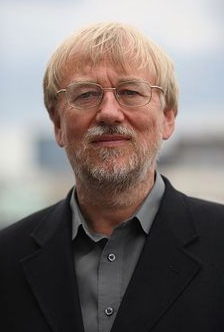





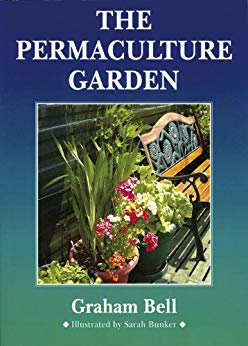




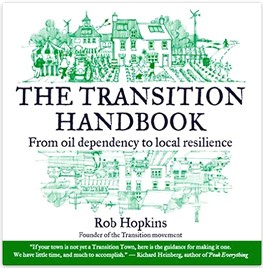

![Sepp Holzer integrierte auch die
Hugenkultur, den Anbau am keilförmigen Damm
[24] [so wird die Anbaufläche verdoppelt] Sepp Holzer integrierte auch die
Hugenkultur, den Anbau am keilförmigen Damm
[24] [so wird die Anbaufläche verdoppelt]](../d/001-chron-d/024-Sepp-Holzer-hugenkultur-anbau-am-keilfoermigen-damm.jpg)
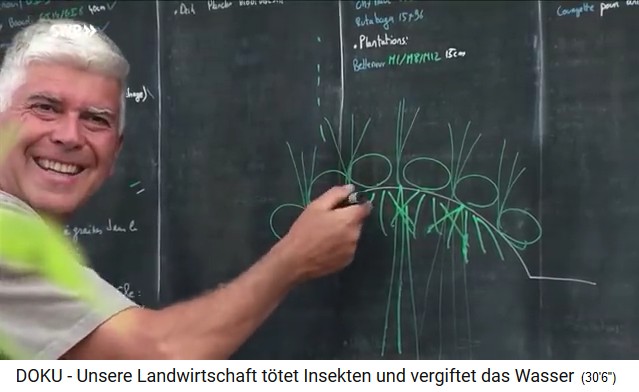



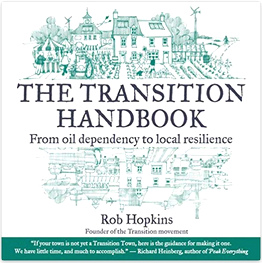

![Buch von Bill Mollison: Handbuch der
Permakulturgestaltung (2012) [37] Buch von
Bill Mollison: Handbuch der Permakulturgestaltung
(2012) [37]](../d/001-chron-d/037-Bill-Mollison-handbuch-der-permakulturgestaltung-2012.jpg)


